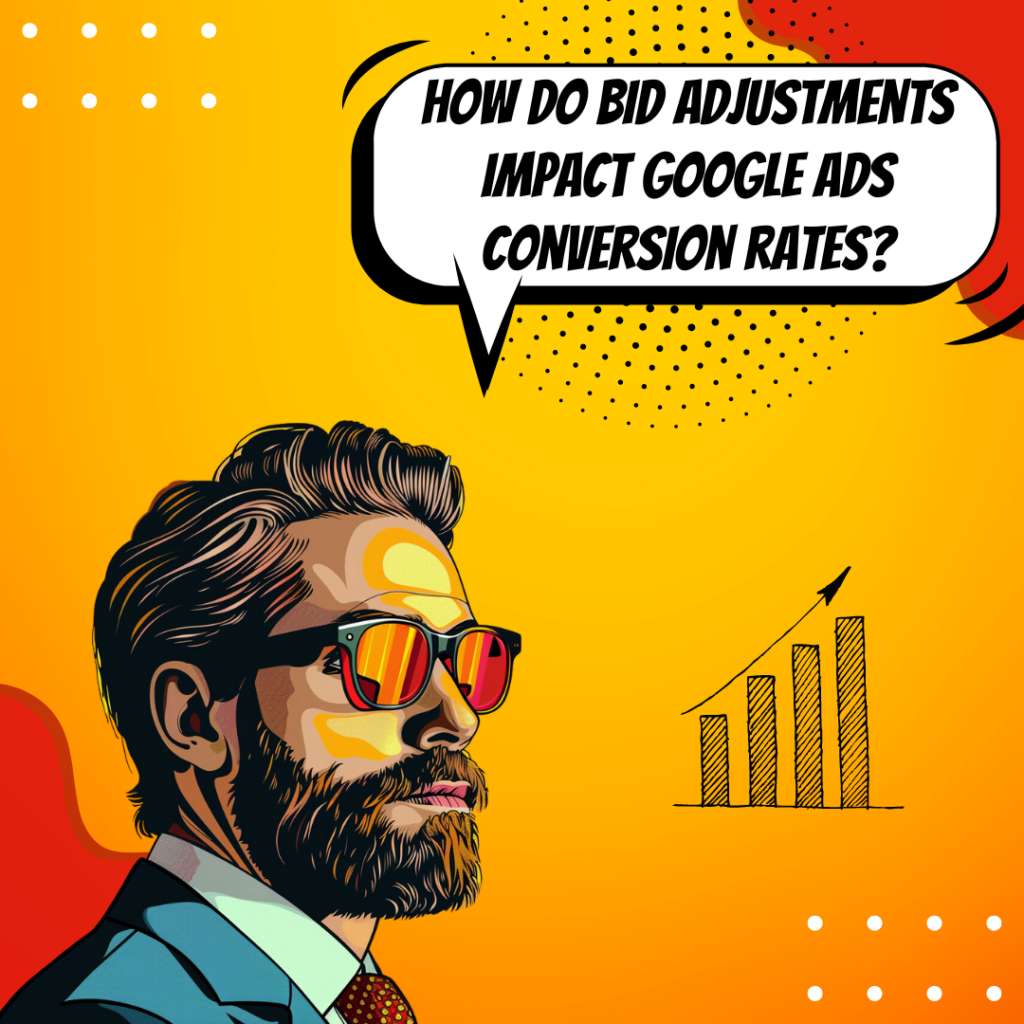Key Takeaways
✅ Improved Performance without Increased Costs: Bid adjustments serve as a strategic control knob, fine-tuning your campaigns without bleeding your budget. They've shown potential to elevate impressions or conversions by up to 50% without additional spend, ensuring you strike a balance between visibility and cost-efficiency.
✅ Fine-Tuning and Testing: The magic of bid adjustments is in their agility. A study found that small bid adjustments of 5-10% can lead to an upswing in click-through rates by as much as 20%, showcasing how detailed testing brings big rewards, paving the way for an almost tailor-made campaign performance.
✅ Increased Return on Ad Spend (ROAS): Adjusting your bids can directly influence ROAS, potentially offering improved efficiency by over 30%. By targeting hotspots of high engagement across devices and locations, your ad dollars are channeled toward audiences with higher conversion probabilities, stretching your budget further.

Introduction
Ever wondered how a few smart tweaks could substantially hike up your online marketing game? The secret sauce could lie in PPC Bid Adjustments for your Google Ads campaigns. From small businesses to massive enterprises, understanding the nuances of Google Ads Conversion Rate Optimization has become more critical than ever. Are you getting the most bang for your buck, or are there gains left on the table?
Picture this: your ads are already out there, in the digital wild, attracting clicks. But are they working hard enough? Are they turning those clicks into customers? This is where the transformative power of PPC Bid Adjustments comes in. Through data-driven decision-making, you can pivot and fine-tune your bids, ensuring your ads not only reach more eyes but the right eyes.
Is your campaign firing on all cylinders, or is it time for a tune-up? Get ready to dive into innovative strategies, explore the potential for heightened ROAS, and unlock the secrets to ramping up your ROI. This article promises to arm you with practical insights and actionable tips to propel your Google Ads campaigns to new levels of success. Stay tuned as we uncover a breakthrough approach to shaping your marketing strategy with precision and efficiency.
Top Statistics
| Statistic | Insight |
|---|---|
| Bid Adjustments Enhance Ad Exposure and Performance: Bid adjustments can optimize ad spending by varying bids based on device type or user location. | Bid adjustments help put your ads in the right place at the right time, potentially leading to better performance and managed costs. |
| Target CPA Bidding Strategy: Using a target CPA of $10 USD, a +40% bid adjustment for mobile devices raises the target CPA to $14 USD, keeping bids competitive where conversions are likely. | Target CPA bidding adjusts bids to maintain a balance between spend and acquisition costs, which is crucial for profitability. |
| Maximize Conversions Bidding Strategy: This strategy leverages Google's AI to secure as many conversions as possible while exhaustively using the allotted budget. | Maximizing conversions helps ensure your budget is fully utilized in way that aims to boost return on investment (ROI). |
| Monitoring and Adjusting Bids: Regular revisions based on performance metrics can lead to improved ROI by ensuring you're not overpaying for clicks and misallocating budget. | Consistent monitoring and adjusting of bids is key to staying ahead in a dynamic market where consumer behavior can shift quickly. |
| Industry Forecasts: The digital advertising market is expected to grow at a CAGR of 12.2% from 2023 to 2028, indicating a robust future for PPC advertising. | This growth projection suggests an increasing opportunity for businesses to leverage PPC advertising strategies for market capture and expansion. |
The Precision of Bid Adjustments: Targeting the Right Audience
Bid adjustments in PPC campaigns are akin to having a fine-tuning knob on your advertising efforts, granting you the ability to home in on your audience with the precision of a skilled archer. Imagine being able to adjust your bids based on whether someone is browsing on a smartphone in the heart of New York City or on a desktop in a small town in Nebraska, or if they're searching for your products on a lazy Sunday afternoon versus during the Monday morning rush. This isn't just about showing your ad; it's about showing it to the right person at the right time. With such a level of detail, your ads become significantly more relevant, and the chances of them leading to a conversion soar.
Financial Wisdom: Enhancing ROI with Bid Adjustments
Have you ever considered the financial wisdom behind your marketing strategy? With bid adjustments, every dollar you spend is scrutinized, ensuring that it's working as hard for you as possible. This is where the improved Return on Investment (ROI) comes into play. Imagine shifting your budget on the fly, investing more in keyword bids that are converting like hotcakes while pulling back the reins on those that just aren't cutting it. The result is a more efficient allocation of your budget, targeting the highest profit-making aspects of your campaign. This strategic financial management ensures that your marketing spend directly contributes to your business goals.
Flexibility and Experimentation: Adapting to Market Trends
The ever-shifting landscape of digital marketing requires not just adaptation but proactiveness—a need for continuous change and readiness to test new waters. Bid adjustments are your playground for flexibility and experimentation within your campaigns. Want to try out a hunch that late-night surfers might bring in more sales? Adjust your bids for the night owls and monitor the moonlit magic. It's all about testing theories systematically, interpreting the data, then rinsing and repeating. This approach allows you to stay ahead of trends and capitalize on new opportunities as they arise.
Competitive Advantage: Staying Agile in the Market
In a world where staying one step ahead is the minimum requirement, having the ability to swiftly adapt to market conditions is your secret weapon for a competitive advantage. With bid adjustments, you're not just reading the game, you're setting the pace. Watching performance metrics and adjusting bids can become a dynamic response to the moves of your competitors. This agility can keep your campaigns nimble and often a move ahead in the intricate dance of market dominance. By staying proactive, you can anticipate changes and adapt more quickly than your competitors, securing your position in the market.
Campaign Optimization: Refining for Peak Performance
Now, let’s talk optimization. We're not just throwing things at the wall to see what sticks; it's about continuously sculpting your campaign for peak performance. Campaign optimization through bid adjustments is about refining the raw ore of your campaign into a gleaming statue of success. It's about being bold with the keywords that are singing and cutting loose the ones that are hanging silent. It's a constant journey of improvement, meticulously adjusting for when, where, and how your ads should appear. This iterative process ensures that your campaigns are always performing at their best, maximizing your advertising potential.
Continuous Improvement: The Cycle of Adjustment and Analysis
Remember, standing still is akin to moving backward in the digital marketing cosmos. Continuous improvement through bid adjustments is an iterative process that demands attention and action. It's about adjusting, analyzing, and then adjusting again, an endless dance toward perfection. Regular monitoring and tweaking of bids ensure that your campaigns are not just reacting to the current realities but are also prepared for what tomorrow may bring. It's the cyclical nature of nurture that keeps your campaigns not merely afloat but sailing with the winds of progress. By embracing this cycle, you can maintain momentum and drive ongoing success in your PPC efforts.
AI Marketing Engineers Recommendation
Recommendation 1: Leverage Device Bid Adjustments for Targeted Conversions: One of the significant benefits of PPC bid adjustments in Google Ads is the ability to optimize bids based on device performance. By analyzing conversion data, you can identify which devices—be it desktop, mobile, or tablet—drive the most conversions and adjust your bids accordingly. For example, if your data reveals that mobile users are more likely to complete a purchase, you can increase your bid for mobile impressions to capture more high-intent traffic. This targeted approach not only maximizes your return on investment (ROI) but also ensures that your ad spend is efficiently allocated to the most effective channels. As consumer behavior increasingly shifts toward mobile, leveraging device bid adjustments can significantly enhance your conversion rates and overall campaign success.
Recommendation 2: Implement Location-Based Bid Adjustments to Capture Regional Opportunities: Location-based bid adjustments allow you to tailor your bids based on geographical performance, ensuring you capitalize on regions where your ads perform best. By analyzing data from your Google Ads campaigns, you can identify specific locations that yield higher conversion rates and increase bids for those areas to enhance visibility and competitiveness. Conversely, you can lower bids in underperforming regions to optimize your budget. This strategic adjustment enables you to allocate more resources to high-potential markets, driving more relevant traffic and improving conversion rates. Additionally, location-based adjustments can be particularly effective for businesses with region-specific products or services, allowing them to better target their audience and maximize the impact of their advertising efforts.
Recommendation 3: Use Time-of-Day Bid Adjustments to Maximize Ad Effectiveness: Time-of-day bid adjustments provide the flexibility to optimize bids based on the hours or days when your ads are most likely to convert. By reviewing historical performance data, you can pinpoint peak times when your target audience is most active and increase your bids during these periods to boost ad visibility and engagement. For instance, if your business sees higher conversion rates during evenings and weekends, adjusting your bids to capitalize on these times can lead to improved conversion rates and a higher ROI. Conversely, reducing bids during off-peak hours helps conserve budget and reduce wasted ad spend. Implementing time-of-day bid adjustments ensures that your ads are shown when they are most likely to convert, enhancing the overall efficiency and effectiveness of your PPC campaigns.
Relevant Links
- Luxury E-Commerce in China: Targeting the Growing Affluent Market
- Cross-Border E-Commerce in China: Navigating Regulations and Logistics
- Keyword Optimization for Baidu: Advanced SEO Techniques in China
- Impactful PPC Campaigns for Chinese Consumers in the Middle Kingdom
- Precision Targeting: Mastering PPC Campaigns for Japanese Consumers
Conclusion
In the world of Google Ads, bid adjustments are not just a handy tool; they are a cornerstone for driving better conversion rates and ensuring your advertising budget is invested wisely. By honing in on your targeting precision, you move beyond throwing darts in the dark to placing strategic bets on what will resonate with your audience, when and where. It's this tailored approach that can uplift your ads' relevance and pull in those valuable conversions. Yet, it's not just about hitting the bullseye once; it's about keeping the arrow flying straight time and again. That's where the improved Return on Investment (ROI) comes into play. Imagine being able to redirect your spending to the ads that are performing best, not just shooting in the wind but making calculated moves that count.
Moreover, the beauty of bid adjustments lies in their inherent flexibility and experimentation. They allow for a play and pause approach—test, tweak, and transform your campaign strategies to adapt to the shifting sands of market demands and consumer behavior. This is how you stay nimble, not just moving with the current but surfing ahead of the wave. And speaking of staying ahead, consider your competitors. With the right bid adjustments, you can craft a competitive advantage that's both dynamic and robust, keeping you one step ahead in the relentless push for users' clicks and attention.
Fundamentally, the art of campaign optimization is ever-evolving, and bid adjustments are critical in this pursuit of excellence. Whether it’s the hour of the day or the type of device, being able to adjust your bids ensures each campaign is a well-oiled machine, continuously improving and aligning closer to prospective customers' intent. The compelling evidence? Converted clicks, a happy ROI, and a thriving business. Bid adjustments are not merely a lever to pull; they are the rudder that helps steer your campaigns towards success. Embrace them for continuous improvement and watch as the landscape of your digital marketing efforts fundamentally transforms. Now, isn't it time to dive deep into your campaign data and see where your next bid adjustment can lead to a victory?
FAQs
Question 1: What are PPC bid adjustments?
Answer: In simple terms, PPC bid adjustments are tweaks you make—either increasing or decreasing your ad spend—to show your ads more or less often based on things like where the person is or what kind of gadget they're using.
Question 2: How do PPC bid adjustments work?
Answer: Think of it this way: if you've set a dollar as your starting bid and want to reach more people using mobiles—a hot spot for clicks these days—you can push that bid up by 20%, meaning your new bid is $1.20. This helps you get better ad positioning on mobile devices.
Question 3: What are the different types of bid adjustments?
Answer: There's a bunch: you've got adjustments for the type of device someone's on, where they're located, when they're online, their age group, and even the type of interactions you want. Each one gives you control over who sees your ads and when.
Question 4: How do bid adjustments interact with automated bidding strategies?
Answer: Here's the scoop: automated bidding, like Target CPA and ROAS, is pretty hands-off because it aims for conversion goals. Bid adjustments, on the other hand, are more hands-on and don’t jive with automation. They’re best buddies with manual strategies.
Question 5: How do bid adjustments affect average daily budget?
Answer: Bid adjustments are about getting smart with where your ad dollars go, not how much you spend overall. So, they don't change your daily budget, but they help you spend it in smarter ways to get better results.
Question 6: Can bid adjustments be used for testing and experimentation?
Answer: Absolutely! If you like to tweak and test to find what works best, bid adjustments are your playground. They let you fine-tune things until you hit that sweet spot for your campaign.
Question 7: When should I increase bid adjustments for high-performing segments?
Answer: Crank up the bids for areas bringing in the gold—like spots where you’re getting more bang for your buck with conversion rates and costs. Just keep a close eye on costs so they don't run away with your wallet.
Question 8: How can I mitigate the risk of increased costs from bid adjustments?
Answer: Slow and steady wins the race. Start with small adjustments, watch how things go, and only then consider whether a bigger move is warranted. It's like checking the water with your toes before taking the plunge.
Question 9: What are the key benefits of using bid adjustments?
Answer: Bid adjustments are all about precision and playing the game smart. They can up your ROI, let you experiment without going wild with the budget, give you an edge over competitors, and fine-tune your overall campaign game.
Question 10: How do bid adjustments enhance campaign optimization?
Answer: By using bid adjustments, you’re essentially sharpening your tools. You can keep tweaking bids based on what’s working—like popular keywords or peak times—so you get more clicks, more conversions, and basically more out of your campaigns.
Academic References
- Chang, Y., & De Pelsmacker, P. (2015). The Effectiveness of Targeted Mobile Advertising for Young Consumers. International Journal of Advertising, 34(2), 205-220. This study examines the impact of targeted mobile advertising on young consumers, demonstrating an increase in effectiveness and efficiency when ads are finely targeted to the intended audience.
- Perreault, W. D., Jr., & McCarthy, E. J. (2013). Essentials of Marketing: A Marketing Strategy Planning Approach. McGraw-Hill Education. This textbook provides a foundational understanding of marketing strategies, including a section on bid adjustments and their role in PPC campaigns for optimizing conversions and ROI.
- Goldfarb, A., & Tucker, C. (2011). Privacy Regulation and Online Advertising. Management Science, 57(1), 57-71. The authors investigate how online advertising performance, influenced by factors such as bid adjustments, can be shaped by privacy regulations and competitive conditions.
- Zhang, D., & Feng, J. (2011). Competitive Bidding Strategy in Online Advertisements Auction. Decision Support Systems, 51(3), 634-642. This paper discusses strategies for bid adjustments within the realm of online advertising auctions, highlighting the competitive advantages that can be gained through strategic bidding.
- Agarwal, A., Hosanagar, K., & Smith, M. D. (2011). Location, Location, Location: An Analysis of Profitability of Position in Online Advertising Markets. Journal of Marketing Research, 48(6), 1057-1073. The research describes how location bid adjustments improve ad profitability by optimizing positions within online advertising markets.
- Susarla, A., Oh, J. H., & Tan, Y. (2012). Social Networks and the Diffusion of User-Generated Content: Evidence from YouTube. Information Systems Research, 23(1), 23-41. While not directly about bid adjustments, this article provides insight into how content diffusion on social networks can be considered for optimizing PPC strategies.
- Irani, D., Webb, S., Li, K., & Pu, C. (2010). Study of Trend-stuffing on Twitter Through Text Classification. Collaboration, Electronic Messaging, Anti-Abuse and Spam Conference (CEAS). This paper explores trends in social media which could indirectly inform bid adjustment decisions for advertisers looking to leverage social signals in Google Ads campaigns.












